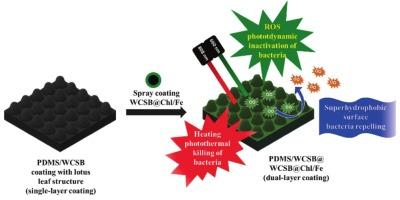结合仿生表面和叶绿素/铁修饰菱角壳生物炭的双层涂层用于抗菌和防护
IF 7.3
2区 材料科学
Q1 CHEMISTRY, APPLIED
引用次数: 0
摘要
细菌感染和生物膜相关问题的增加增加了对多功能抗菌涂层的需求。在这项研究中,我们开发了一种结合光热和光动力抗菌性能的生物炭基材料。从荸荠壳中提取的生物炭具有固有的光热特性。在叶绿素/Fe (Chl/Fe)配合物表面修饰后,它也获得了在660 nm光下产生活性氧的能力。所得WCSB@Chl/Fe在808 nm辐照下表现出较强的单线态氧和羟基自由基生成,光热转换效率为45%。通过喷涂技术将多功能WCSB@Chl/Fe结合到莲叶启发的聚二甲基硅氧烷(PDMS)双层涂层中。微纳表面图案化增强了疏水性,减少了细菌粘附,而光热和光动力联合效应导致金黄色葡萄球菌和大肠杆菌在光激活后的数量减少了6倍。除了抗菌效果外,该涂层在应用于金属基材时也表现出更好的耐腐蚀性。这些发现突出了WCSB@Chl/ fe基涂层作为生物医学设备和需要抗菌保护和结构耐久性的公共卫生表面的稳健和可持续解决方案的潜力。本文章由计算机程序翻译,如有差异,请以英文原文为准。

Dual-layer coatings combining biomimetic surface with chlorophyll/Fe modified water chestnut-shell biochar for antibacterial and protective applications
The rise of bacterial infections and biofilm-associated issues has increased the demand for multifunctional antibacterial coatings. In this study, we developed a biochar-based material that combines photothermal and photodynamic antibacterial properties. Biochar derived from water chestnut shells (WCSB) exhibits inherent photothermal behavior. After surface modification with a chlorophyll/Fe (Chl/Fe) complex, it also gains the ability to generate reactive oxygen species under 660 nm light. The resulting WCSB@Chl/Fe shows strong singlet oxygen and hydroxyl radical production and achieves a photothermal conversion efficiency of 45 % under 808 nm irradiation. The multifunctional WCSB@Chl/Fe was incorporated into a lotus-leaf-inspired polydimethylsiloxane (PDMS) bilayer coating via spray-coating techniques. The micro-nano surface patterning enhanced hydrophobicity and reduced bacterial adhesion, while the combined photothermal and photodynamic effects led to a 6-log reduction in S. aureus and E. coli populations after light activation. In addition to its antimicrobial efficacy, the coating also demonstrated improved corrosion resistance when applied to metal substrates. These findings highlight the potential of WCSB@Chl/Fe-based coatings as robust and sustainable solutions for biomedical devices and public health surfaces requiring both antibacterial protection and structural durability.
求助全文
通过发布文献求助,成功后即可免费获取论文全文。
去求助
来源期刊

Progress in Organic Coatings
工程技术-材料科学:膜
CiteScore
11.40
自引率
15.20%
发文量
577
审稿时长
48 days
期刊介绍:
The aim of this international journal is to analyse and publicise the progress and current state of knowledge in the field of organic coatings and related materials. The Editors and the Editorial Board members will solicit both review and research papers from academic and industrial scientists who are actively engaged in research and development or, in the case of review papers, have extensive experience in the subject to be reviewed. Unsolicited manuscripts will be accepted if they meet the journal''s requirements. The journal publishes papers dealing with such subjects as:
• Chemical, physical and technological properties of organic coatings and related materials
• Problems and methods of preparation, manufacture and application of these materials
• Performance, testing and analysis.
 求助内容:
求助内容: 应助结果提醒方式:
应助结果提醒方式:


